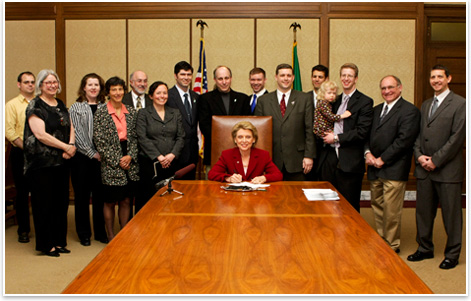|
Washington State Adopts AIA’s 2030 Goals
How do you . . . bring a coalition together to enact AIA-generated law?
Summary: On Friday, May 8, Washington Gov. Chris Gregoire signed the Efficiency First Bill, S.B. 5854, which sets the goal of carbon neutrality for all new public and private new buildings and major restorations by 2031. The new state law is due in large part to the efforts of AIA members in Washington State. The bill was drafted by the AIA Washington Council, along with a coalition from the environmental community.

“Architect support of the bill was critical to its passage,” says AIA Washington Council Executive Director Stan Bowman. “Architects ensured that the bill was reasonable in its provisions and acceptable to the larger business community. The AIA Washington Council is pleased to be the first state to legislatively adopt the AIA’s 2030 goals for carbon neutrality in statute for all public and private buildings in Washington State.”
“The national AIA component extends its congratulations to the AIA Washington Council for bringing the 2030 goal for carbon reductions to the forefront of their governor’s sustainability agenda,” says AIA Executive Vice President/CEO Chris McEntee. “This effort on the part of AIA Washington is an impressive example of what AIA members can accomplish when they act in concert and in coalition with other organizations.”
Emphasizing her long-term commitment to environmental protection, on May 21, the governor additionally issued an executive order directing state actions to reduce climate-changing greenhouse gas emissions, increase transportation and fuel-conservation options for Washingtonians, and protect the state’s water supplies and vulnerable coastal areas.
Provisions of the law
The law will gradually raise standards for new building construction, while improving energy efficiency in existing public buildings through insulation, better windows and improved heating and cooling systems.
Although specific emissions reduction percentages aren’t set, the bill requires the state energy code to be designed to accelerate construction of increasingly energy-efficient buildings that help achieve the broader goal of building zero fossil-fuel greenhouse gas emission homes and buildings by the year 2031. It also requires the state building code council to adopt state energy codes from 2013 through 2031 that incrementally move toward achieving a 70 percent reduction in annual net-energy consumption. As such, this legislation will make Washington a leader in environmental building methods. Washington is the first state to legislatively adopt the AIA 2030 goals into its building code.
To that end, the State Building Code Commission recently voted to adopt the 2009 International Energy Conservation Code by 2011, replacing the existing state energy code.
The measures also will require utilities to track and disclose energy use data in large commercial and public buildings they serve through the ENERGY STAR Portfolio Manager. The requirements will be phased in to include buildings larger than 50,000 square feet starting January 1, 2011 and buildings larger than 10,000 square feet starting January 1, 2012.
The promise of jobs and economic growth
Another benefit of the bill, according to the Puget Sound Business Journal, is that the impact of this legislation could create many jobs for architects. The Journal quoted the American Council for an Energy-Efficient Economy that a 20 percent increase in buildings energy efficiency nationwide by 2020 could create 800,000 jobs.
“There’s a real opportunity here to do two critical things—save money and grow our economy,” said Sen. Derek Kilmer (D-Gig Harbor). “Energy efficiency is one of the few bright spots in these tough economic times. This bill will help lower utility bills for consumers across the state while putting people to work using skills they already have.”
|



